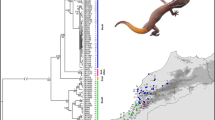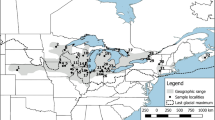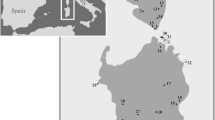Abstract
The identification of species boundaries for allopatric populations is important for setting conservation priorities and can affect conservation management decisions. Tuatara (Sphenodon) are the only living members of the reptile order Sphenodontia and are restricted to islands around New Zealand that are free of introduced mammals. We present new data of microsatellite DNA diversity and substantially increased mtDNA sequence for all 26 sampled tuatara populations. We also re-evaluate existing allozyme data for those populations, and together use them to examine the taxonomic status of those populations. Although one could interpret the data to indicate different taxonomic designations, we conclude that, contrary to current taxonomy, Sphenodon is best described as a single species that contains distinctive and important geographic variants. We also examine amounts of genetic variation within populations and discuss the implications of these findings for the conservation management of this iconic taxon.







Similar content being viewed by others
References
Aitken N, Hay JM, Sarre SD et al (2001) Microsatellite DNA markers for tuatara (Sphenodon spp.). Conserv Genet 2:183–185
Allendorf FW (2001) Genetics and viability of insular populations of reptiles. N Z J Zool 28:361
Allendorf FW, Leary RF (1988) Conservation and distribution of genetic variation in a polytypic species, the cutthroat trout. Conserv Biol 2:170–184
Allendorf FW, Luikart G (2007) Conservation and the genetics of populations. Blackwell, Malden
Anonymous (1987) Tuatara traded for drugs. Oryx 21:125
Apesteguía S, Novas FE (2003) Large Cretaceous sphenodontian from Patagonia provides insight into lepidosaur evolution in Gondwana. Nature 425:609–612
Bandelt H-J, Forster P, Röhl A (1999) Median-joining networks for inferring intraspecific phylogenies. Mol Biol Evol 16:37–48
Benton MJ (1993) The fossil record 2. Chapman & Hall, London
Benton MJ (2000) Vertebrate palaeontology, 2nd edn. Blackwell, Oxford
Bowcock AM, Ruíz-Linares A, Tomfohrde J et al (1994) High resolution human evolutionary trees with polymorphic microsatellites. Nature 368:455–457
Brehm A, Harris DJ, Alves C, Jesus J, Thomarat F, Vicente L (2003) Structure and evolution of the mitochondrial DNA complete control region in the lizard Lacerta dugesii (Lacertidae, Sauria). J Mol Evol 56:46–53
Brook FJ, McArdle BH (1999) Morphological variation, biogeography and local extinction of the northern New Zealand landsnail Placostylus hongii (Gastropoda: Bulimulidae). J R Soc N Z 29:407–434
Buller WL (1877) Notes on the tuatara lizard (Sphenodon punctatum), with a description of a supposed new species. Trans Proc N Z Inst 1876(9):317–325
Buller WL (1878) Notice of a new variety of tuatara lizard (Sphenodon) from East Cape Island. Trans Proc N Z Inst 1877(10):220–221
Buller WL (1879) Further notes on the habits of the tuatara lizard. Trans Proc N Z Inst 1878(11):349–351
Cavalli-Sforza LL, Edwards AWF (1967) Phylogenetic analysis: models and estimation procedures. Am J Hum Genet 19:233–257
Cornuet JM, Luikart G (1996) Description and power analysis of two tests for detecting recent population bottlenecks from allele frequency data. Genetics 144:2001–2014
Cree A, Butler D (1993) Tuatara recovery plan (Sphenodon spp.). Threatened species recovery plan series no. 9. New Zealand Department of Conservation, Wellington
Daugherty CH, Cree A, Hay JM, Thompson MB (1990) Neglected taxonomy and continuing extinctions of tuatara (Sphenodon). Nature 347:177–179
Daugherty CH, Towns DR, Cree A, Hay JM (1992) The roles of legal protection versus intervention in conserving the New Zealand tuatara, Sphenodon. Dev Landsc Manag Urb Plan 7:247–259
Dawbin WH (1962) The tuatara in its natural habitat. Endeavour 21:16–24
Dieringer D, Schlötterer C (2003) Microsatellite analyser (MSA): a platform independent analysis tool for large microsatellite data sets. Mol Ecol Notes 3:167–169
Duncan RP, Blackburn TM, Worthy TH (2002) Prehistoric bird extinctions and human hunting. Proc R Soc Lond B Biol Sci 269:517–521
Excoffier L, Smouse P, Quattro J (1992) Analysis of molecular variance inferred from metric distances among DNA haplotypes: application to human mitochondrial DNA restriction data. Genetics 131:479–491
Excoffier L, Laval G, Schneider S (2005) Arlequin ver. 3.0: an integrated software package for population genetics data analysis. Evol Bioinform Online 1:47–50
Felsenstein J (2005) PHYLIP (phylogeny inference package) version 3.6. Distributed by the author. Department of Genome Sciences, University of Washington, Seattle
Finch MO, Lambert DM (1996) Kinship and genetic divergence among populations of tuatara Sphenodon punctatus as revealed by minisatellite DNA profiling. Mol Ecol 5:651–658
Frankham R (1996) Relationship of genetic variation to population size in wildlife. Conserv Biol 10:1500–1508
Fraser WM (1925) The Poor Knights Islands: a brief account of the Maori occupation. N Z J Sci Technol 8:8–14
Gaggiotti OE, Lange O, Rassmann K, Gliddon C (1999) A comparison of two indirect methods for estimating average levels of gene flow using microsatellite data. Mol Ecol 8:1513–1520
Gaze P (2001) Tuatara recovery plan 2001–2011. Threatened species recovery plan series no. 47. New Zealand Department of Conservation, Wellington
Goldstein DB, Ruiz Linares A, Cavalli-Sforza LL, Feldman MW (1995) Genetic absolute dating based on microsatellites and the origin of modern humans. Proc Natl Acad Sci USA 92:6723–6727
Goudet J (2001) FSTAT, a program to estimate and test gene diversities and fixation indices (version 2.9.3.2). Available via http://www.unil.ch/izea/softwares/fstat.html Accessed Feb 2002
Goudet J, Raymond M, Demeeus T, Rousset F (1996) Testing differentiation in diploid populations. Genetics 144:1933–1940
Hanley TC, Caccone A (2005) Development of primers to characterize the mitochondrial control region of Galápagos land and marine iguanas (Conolophus and Amblyrynchus). Mol Ecol Notes 5:599–601
Hay JM, Daugherty CH, Cree A, Maxson LR (2003) Low genetic divergence obscures phylogeny among populations of Sphenodon, remnant of an ancient reptile lineage. Mol Phylogenet Evol 29:1–19
Hay JM, Sarre S, Daugherty CH (2004) Nuclear mitochondrial pseudogenes as molecular outgroups for phylogenetically isolated taxa: a case study in Sphenodon. Heredity 93:468–475
Hayward BW (1986) Origin of the offshore islands of northern New Zealand and their landform development. The offshore islands of Northern New Zealand, New Zealand Department of Lands and Survey information series 16, New Zealand Department of Lands and Survey, Wellington, New Zealand, pp 129–138
Hayward BW (1991) Geology and geomorphology of the Poor Knights Islands, northern New Zealand. Tane 33:23–37
Keogh JS, Scott IAW, Hayes C (2005) Rapid and repeated origin of insular gigantism and dwarfism in Australian tiger snakes. Evolution 59:226–233
King M (2003) The penguin history of New Zealand. Penguin Books, Auckland
Kumar S, Tamura K, Nei M (2004) MEGA3: integrated software for molecular evolutionary genetics analysis and sequence alignment. Brief Bioinformatics 5:150–163
Lande R (1999) Extinction risks from anthropogenic, ecological and genetic factors. In: Landweber LF, Dobson AP (eds) Genetics and the extinction of species: DNA and the conservation of biodiversity. Princeton University Press, Princeton
Leberg PL (1992) Effects of population bottlenecks on genetic diversity as measured by allozyme electrophoresis. Evolution 46:477–494
Luikart G, Cornuet JM (1998) Empirical evaluation of a test for identifying recently bottlenecked populations from allele frequency data. Conserv Biol 12:228–237
Luikart G, Allendorf FW, Cornuet JM, Sherwin WB (1998a) Distortion of allele frequency distributions provides a test for recent population bottlenecks. J Hered 89:238–247
Luikart G, Sherwin WB, Steele BM, Allendorf FW (1998b) Usefulness of molecular markers for detecting population bottlenecks via monitoring genetic change. Mol Ecol 7:963–974
MacAvoy ES, McGibbon LM, Sainsbury JP et al (2007) Genetic variation in island populations of tuatara (Sphenodon spp.) inferred from microsatellite markers. Conserv Genet 8:305–318
Mayr E (1963) Animal species and evolution. Belknap Press of Harvard University Press, Cambridge
Menozzi P, Piazza A, Cavalli-Sforza L (1978) Synthetic maps of human gene frequencies in Europeans. Science 201:786–792
Moore JA, Nelson NJ, Keall SN, Daugherty CH (2008) Implications of social dominance and multiple paternity for the genetic diversity of a captive-bred reptile population (tuatara). Conserv Genet 9:1243–1252
Nei M (1978) Estimation of average heterozygosity and genetic distance from a number of individuals. Genetics 89:538–590
Nei M, Tajima F, Tateno Y (1983) Accuracy of estimated phylogenetic trees from molecular data. J Mol Evol 19:153–170
Nelson NJ, Keall SN, Brown D, Daugherty CH (2002a) Establishing a new wild population of tuatara (Sphenodon guntheri). Conserv Biol 16:887–894
Nelson NJ, Keall SN, Pledger S, Daugherty CH (2002b) Male-biased sex ratio in a small tuatara population. J Biogeogr 29:633–640
Newman DG (1986) Can tuatara and mice co-exist? The status of tuatara, Sphenodon punctatus (Reptilia: Rhynchocephalia), on the Whangamata Islands. The offshore islands of New Zealand, New Zealand Department of Lands and Survey information series 16, New Zealand Department of Lands and Survey, Wellington, New Zealand, pp 179–185
Paetkau D, Calvert W, Stirling I, Strobeck C (1995) Microsatellite analysis of population structure in Canadian polar bears. Mol Ecol 4:347–354
Paetkau D, Waits LP, Clarkson PL, Craighead L, Strobeck C (1997) An empirical evaluation of genetic distance statistics using microsatellite data from bear (Ursidae) populations. Genetics 147:1943–1957
Parent CE, Caccone A, Petren K (2008) Colonization and diversification of Galápagos terrestrial fauna: a phylogenetic and biogeographical synthesis. Proc R Soc B 363:3347–3361
Paterson H (2005) The competitive Darwin. Paleobiology 31:56–76
Piry S, Luikart G, Cornuet J-M (1999) BOTTLENECK: a computer program for detecting recent reductions in the effective population size using allele frequency data. J Hered 90:502–503
Posada D, Crandall KA (1998) Modeltest: testing the model of DNA substitution. Bioinformatics 14:817–818
Raymond M, Rousset F (1995) GENEPOP (version 1.2): population genetics software for exact tests and ecumenicism. J Hered 86:248–249
Reich D, Price AL, Patterson N (2008) Principal component analysis of genetic data. Nat Genet 40:491–492
Rest JS, Ast JC, Austin CC et al (2003) Molecular systematics of primary reptilian lineages and the tuatara mitochondrial genome. Mol Phylogenet Evol 29:289–297
Rice WR (1989) Analyzing tables of statistical tests. Evolution 43:223–225
Ryder OA (1986) Species conservation and systematics: the dilemma of subspecies. Trends Ecol Evol 1:9–10
Sarre SD, Schwaner T, Georges A (1990) Genetic variation among insular populations of the sleepy lizard, Trachydosaurus rugosus gray (Squamata: Scincidae). Aust J Zool 38:603–616
Schneider S, Roessli D, Excoffier L (2000) Arlequin ver. 2.000: a software for population genetic data analysis. Genetics and Biometry Laboratory, University of Geneva, Switzerland
Soulé M, Yang SY (1973) Genetic variation in side-blotched lizards on islands in the Gulf of California. Evolution 27:593–600
Subramanian S, Hay JM, Mohandesan E, Millar CD, Lambert DM (2008) Molecular and morphological evolution in tuatara are decoupled. Trends in Genetics 25:16–18
Swofford DL (2003) PAUP* phylogenetic analysis using parsimony (*and other methods) Version 4. Sinauer Associates, Sunderland
Terrasa B, Pérez-Mellado V, Brown RP, Picornell A, Castro JA, Ramon MM (2009) Foundations for conservation of intraspecific genetic diversity revealed by analysis of phylogeographical structure in the endangered endemic lizard Podarcis lilfordi. Divers Distrib 15:207–221
Waples RS (1991) Pacific salmon, Onchorhynchus spp., and the definition of ‘species’ under the endangered species act. Mar Fish Rev 53:11–22
Waser PM, Strobeck C (1998) Genetic signatures of interpopulation dispersal. Trends Ecol Evol 13:43–44
Whitaker AH (1968) The lizards of the Poor Knights Islands, New Zealand. N Z J Sci 11:623–651
Whittaker RJ, Triantis KA, Ladle RJ (2008) A general dynamic theory of oceanic island biogeography. J Biogeogr 35:977–994
Wilson AC, Cann RL, Carr SM et al (1985) Mitochondrial DNA and two perspectives on evolutionary genetics. Biol J Linn Soc Lond 26:375–400
Acknowledgments
We thank Niccy Aitken and members of the Sarre and Lambert labs for technical and analytical assistance and reviewers for helpful comments on the manuscript. JMH and this research were funded by a New Zealand Foundation for Research Science and Technology Postdoctoral Fellowship, and subsequently a Marsden Fund grant to DML and the Allan Wilson Centre for Molecular Ecology and Evolution.
Author information
Authors and Affiliations
Corresponding author
Electronic supplementary material
Below is the link to the electronic supplementary material.
Rights and permissions
About this article
Cite this article
Hay, J.M., Sarre, S.D., Lambert, D.M. et al. Genetic diversity and taxonomy: a reassessment of species designation in tuatara (Sphenodon: Reptilia). Conserv Genet 11, 1063–1081 (2010). https://doi.org/10.1007/s10592-009-9952-7
Received:
Accepted:
Published:
Issue Date:
DOI: https://doi.org/10.1007/s10592-009-9952-7




